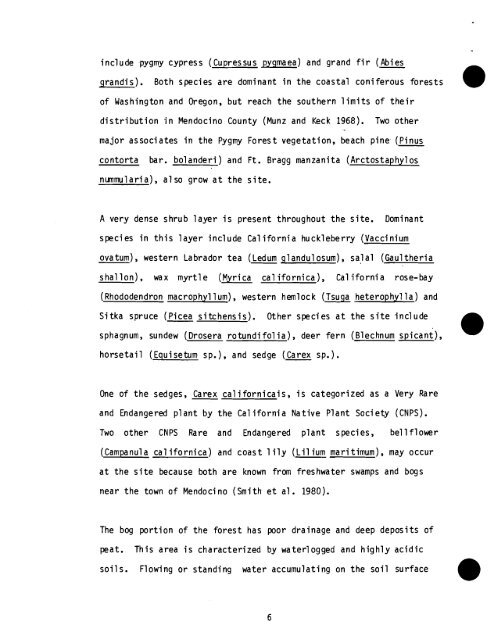Lotis Blue Butterfly Recovery Plan - U.S. Fish and Wildlife Service
Lotis Blue Butterfly Recovery Plan - U.S. Fish and Wildlife Service
Lotis Blue Butterfly Recovery Plan - U.S. Fish and Wildlife Service
You also want an ePaper? Increase the reach of your titles
YUMPU automatically turns print PDFs into web optimized ePapers that Google loves.
include -pygmy cypress (Cupressus pygmaea) <strong>and</strong> gr<strong>and</strong> fir (hies<br />
gr<strong>and</strong>is). Both species are dominant in the coastal coniferous forests<br />
of Washington <strong>and</strong> Oregon, but reach the southern limits of their<br />
distribution .in Mendocino County (Munz <strong>and</strong> Keck 1968). Two other<br />
major associates in the Pygmy Forest vegetation, beach pine. (Pinus<br />
contorta bar. bol<strong>and</strong>eri ) <strong>and</strong> Ft. Bragg manzanita (Arctostaphyl os<br />
nummularia), also grow at the site.<br />
A very dense shrub layer is present throughout the site. Dominant<br />
species in this layer include Cal ifornia huckleberry (Vaccinium<br />
ovatum), western Labrador tea (Ledum gl<strong>and</strong>ul osum), salal (Gaul theria<br />
shallon), wax myrtle (Myrica californica), California rose-bay<br />
(Rhododendron macrophyllum), western halock (Tsuga heterophylla) <strong>and</strong><br />
Sitka spruce (Picea - sitchensis). Other species at the site include<br />
sphagnum, sundew (Drosera rotundi fol ia), deer fern (Blechnum spicant),<br />
horsetail (Equisetum sp.), <strong>and</strong> sedge (Carex sp.) .<br />
One of the sedges, Carex californicais, is categorized as a Very Rare<br />
<strong>and</strong> Endangered plant by the California Native <strong>Plan</strong>t Society (CNPS).<br />
Two other CNPS Rare <strong>and</strong> Endangered plant species, bellflower<br />
(Campanula cal ifornica) <strong>and</strong> coast 1 ily (Lil ium mari timum), may occur<br />
at the site because both are known from freshwater swamps <strong>and</strong> bogs<br />
near the town of Mendocino (Smith et al. 1980).<br />
The bog portion of the forest has poor drainage <strong>and</strong> deep deposits of<br />
peat. This area is characterized by waterlogged <strong>and</strong> highly acidic<br />
soils. Flowing or st<strong>and</strong>ing water accumulating on the soil surface 0

















